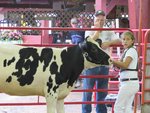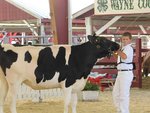 Narrowsburg
NarrowsburgLight Rain Fog/Mist, 43°
Wind: 8.1 mph
 Narrowsburg
NarrowsburgHi, we are Tyler and Olivia Gries. We are third-generation members of the Calkins 4-H Agricultural Club and the fifth generation to live on the family dairy farm in Boyds Mills. We have five dairy …
Stay informed about your community and support local independent journalism.
Subscribe to The River Reporter today. click here
This item is available in full to subscribers.
Please log in to continue |


Hi, we are Tyler and Olivia Gries. We are third-generation members of the Calkins 4-H Agricultural Club and the fifth generation to live on the family dairy farm in Boyds Mills. We have five dairy animals and four market hogs we will be showing at the Wayne County Fair.
Our animals are red-and-white and black-and-white Holsteins. Once our heifers (female cattle that have not yet had a calf) have been bred, the cows go into the milking herd, and their new calves are taken as our 4-H projects. 4-H dairy animals must be from registered stock. That means that the dam (mother) and sire (father) have registration papers.
To start the project, you must choose an animal with correct stature, feet and legs. The body should be long and have a nice-looking head. You should get them when they are young, so they get used to you and having you work with them.
The Holsteins need a clean pen, fresh water and feed, and hay twice a day. When they are still young they get milk until they are about three months old. Then they are weaned to water.
When the animals are three to five months old, we start accustoming them to a halter. We take them out in the barnyard and walk them around. We also start bathing them to keep them clean.
To prepare for the Wayne County Fair, we need to be sure to have the veterinarian come give them the necessary vaccines. Their feet have to be trimmed and shaped to be sure the animal walks and stands correctly.
Our show box must be packed with all of our soaps, halters, brushes, hoses, feed pans, watering pails, clippers, chains to tie the animals, scissors to trim hair in the ears and Q-tips to clean the ears. Also, you need to bring your own wheelbarrow, shovels and forks for keeping your animal’s stall clean. You need to bring enough feed and hay for the week.
For the dairy shows we need to be dressed in white clothes and wear work shoes. That’s because the judge is looking at your animal, and being dressed in white helps him to be more focused on the animal.
During a dairy show, you take your animal into the ring and walk around in a circle. The judge is watching as you come into the show ring. You need to keep your eyes on the judge as well to be sure your animal is walking correctly and standing correctly when you are placed. You are showing off your animal to your best abilities. The show is all about the animal, not you.
There are three classes: Open Show, which is open to anyone, not just 4-H members; Showmanship, which focuses on how well you have trained your animal, how clean it is and your knowledge of breeding information; and Type, where the animals are judged on their breeding and their body builds, from which characteristics the judges can tell how well they will produce.
Wayne County was the largest dairy producer in PA years ago. Due to the low milk prices, farms are on the decrease. It is hard for family farms to succeed. Most of the time one or both parents are working off the farm to help support the farm. But we both enjoy working with our animals and 4-H. We meet new friends and have a great time at the Wayne County Fair.
Comments
No comments on this item Please log in to comment by clicking here